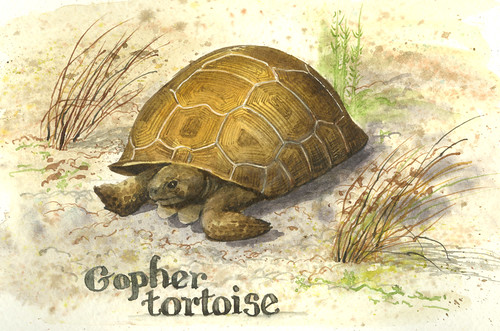Sunday, November 27, 2011
Gopher tortoise
Last week when I visited the Naples Preserve, I sketched a gopher tortoise burrow as part of my nature journal entry about the coastal plain honeycomb head wildflower. It’s funny how a drawing can start trains of thought and exploration. Although I didn’t see any tortoises that day, the burrow opening itself led me to wonder about the gopher tortoise: what they eat and how they live.
Gopher tortoises are found throughout Florida, and range into Georgia, Alabama, Mississippi, and the southernmost tip of South Carolina. Although once common, their numbers have dwindled because of habitat destruction. In Florida, they're the Endangered Species List as a Threatened Species.
Gopher tortoises are a keystone species. A keystone is the wedge-shaped piece at the top of an arch that supports the other parts. If a keystone is removed, the arch collapses. A keystone species has a disproportionately large effect on its environment relative to its quantity.
For example, it’s been estimated that gopher tortoise burrows (both active and abandoned) provide support for over 300 types of animals, birds, and insects – which use them for shelter, hiding places, or protection from the elements. These are commensal relationships, relationships in which one organism benefits while the other is neither harmed nor helped.
Gopher tortoise burrows average 15 ft. in length and may be as deep as 6 feet. The longest estimate is up to 48 ft. in length! The burrows have one entrance/exit, and eventually open up into a larger “bedroom.” Species found using these burrows range from burrowing owls and scrub jays to Florida mice, gopher frogs, opossums, scorpions, and indigo snakes.
Some other interesting things I learned about gopher tortoises:
•They first appeared during the Pleistocene Epoch, and are one of our oldest living species.
•Gopher tortoises are land reptiles – they do not live in or near the water! In fact, they rarely drink water, getting fluids from the plants they eat.
•They live in areas with easy to dig sand, such as pine flatwoods and scrub habitats.
•The size of the burrow opening corresponds to the size of the tortoise using it.
•They are herbivore scavengers, eating grasses, legumes, mushrooms, fruits, berries, and even flowers.
•Biologists believe that they have a 40 to 60 year life span in the wild, they live much longer in captivity.
Some websites on gopher tortoises for further exploration:
Ginny Stibolt's account of finding a gopher tortoise in her Florida backyard, with in-depth facts.
Florida Fish and Wildlife Conservation Commission page
Students, parents and teachers: you can click here to download a free gopher tortoise coloring page in PDF format.
Subscribe to:
Post Comments (Atom)


I loved the post, Elizabeth! Your painting of the tortoise is beautiful, and I enjoyed learning about them too. I've never seen one...
ReplyDeleteIhave seen these tortoises a few times when in Fl. Your sketch is great.
ReplyDeleteLovely page and interesting info. I love gopher tortoises and we see them quite often in our neighborhood, even in our yard.
ReplyDeleteThanks, Kelly! Sometime when you next visit Florida, you'll have to visit some scrub areas and hopefully see them.
ReplyDeleteHi Lisa - glad you got to see them! Sometimes they like to stay in their burrows. Thank you!
How great to have them in your yard!
Thank you all for your kind words!
I posted an additional link on gopher tortoises, a post by Ginny Stibolt about the gopher tortoise in her "yard" along with some in-depth information about them. Be sure to take a look at it!
ReplyDelete